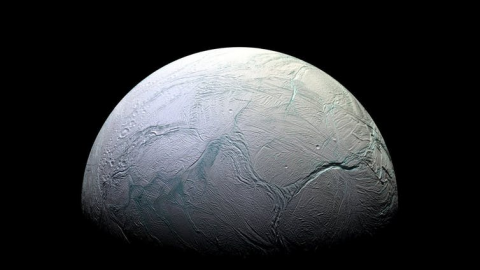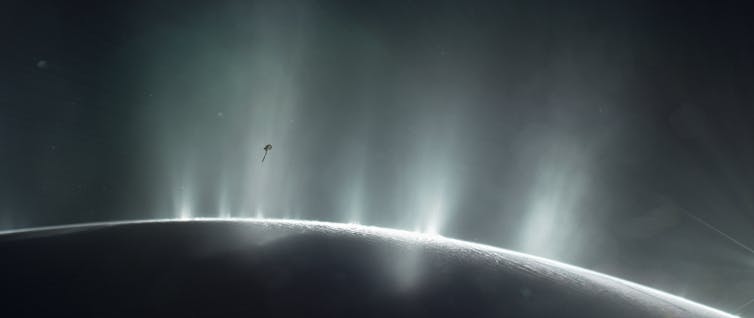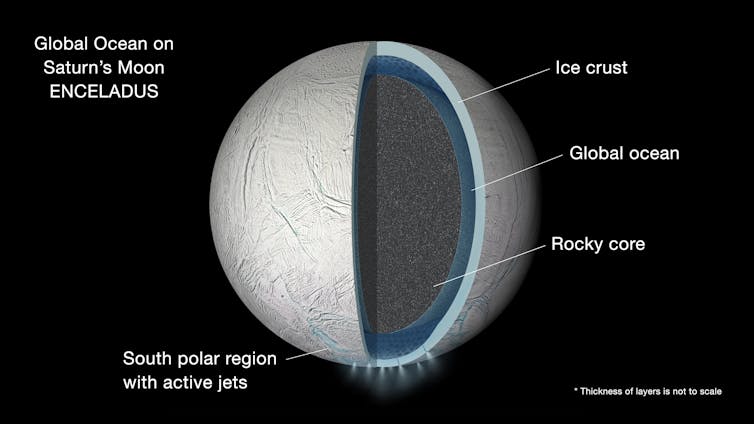The internal ocean of Saturn’s moon Enceladus could be old enough to have evolved life, finds study

We recently bade farewell to the Cassini spacecraft, which after 13 years of faithfully orbiting Saturn and its moons was directed to plunge into the giant planet’s atmosphere. The reason for the “grand finale” was to guard against the possibility that Cassini might crash into one of Saturn’s moons – in particular Enceladus.
With its curtain of geysers and internal ocean, Enceladus is unique. As a result, this small, icy moon is currently regarded as a potential host for life, and so no chance was taken that it might become contaminated by the Cassini spacecraft. Now new research, published in Nature Astronomy, suggests this ocean has existed within Enceladus for a very long time – possibly long enough to create the conditions to develop life.
The geysers are plumes of salty water-ice mixed with traces of carbon dioxide, ammonia, methane and other hydrocarbons that erupt along cracks in Enceladus’ south polar region. It was because of these geysers that scientists could work out that Enceladus must have an ocean below its icy crust and that the ocean is active (convecting). A subsequent observation that hydrogen was present in the plumes led to an additional conclusion, that hydrothermal activity – chemical reactions due to the interaction of water and rock – was taking place. But what scientists have failed to explain is what heat source could be powering this activity.
As more observations of the location of the plumes were made, the mystery of the missing heat source increased. The geysers are associated with features known as “tiger stripes” – a set of four, parallel depressions, about 100km long and 500m deep. The temperature of the stripes is higher than that of the rest of the icy crust, so it was assumed that they must be cracks in the ice. There are almost no impact craters in the tiger stripes region, so it must be very young, of the order of a million-years-old. Any model that purported to explain the heat source had also to account for its focused nature – the ocean is global, but why is only the south polar region active?
 Artist’s impression showing Cassini driving through geysers. NASA
Artist’s impression showing Cassini driving through geysers. NASA
For several years, scientists have favoured the explanation of “tidal heating” – a result of interactions between planetary-sized bodies. For instance tidal interaction with our own moon is responsible for the ebb and flow of water on Earth. Enceladus is in orbital resonance with the similar-sized moon Dione, which affects the shape of Enceladus’ orbit around Saturn. The effect, however, is insufficient to account for the power required to keep the geysers active – calculated to be in the order of 5GW. This would be sufficient power for a city the size of Chicago.
Porous core
Researchers came a step closer to solving the puzzle when they looked at the internal structure of Enceladus. The moon has a density low enough to imply mainly ice with a small, rocky core. This observation has been known for many years, ever since the Voyager 2 mission took the first images of Enceladus and determined its radius, so allowing its volume to be calculated. The gravitational tug of Enceladus on Cassini allowed the moon’s mass to be estimated, giving a value for the density of the body. Gravity measurements by Cassini showed that the core also had a low density which could be interpreted as the core being porous, with the pores filled with ice.
 What was once thought to be a solid, rocky core may actually be porous. NASA
What was once thought to be a solid, rocky core may actually be porous. NASA
The new series of calculations fills the core’s pores with water, rather than ice, from which the authors show that tidal forces associated with the pore water are more than sufficient to explain how Enceladus’ heat is generated. The model is impressive because it is so thorough – considering not just the porosity of the core, but its permeability (how easily fluids can move through it) and how strong it is (will it shatter or flex as fluids run through it?). The researchers apply similar detail to the fluid, with consideration of its viscosity (how runny it is), temperature and composition, as well as its convective properties (how well can it transport heat).
Taking all these parameters together and assigning either known or conservatively assessed values to them results in a fearsome complex of equations. Fortunately, the authors (or, at least, their computer software) can solve the equations to produce an elegant model of heat flow within Enceladus.
The authors create a 3D picture of where and how heat from tidal movements within the pore spaces is transferred to the sub-surface ocean. They find that heat dissipation from the core is not homogeneous, but appears as a series of interlinked, narrow upwellings where temperatures are in excess of 363K (85°C), with hotspots mainly at the south pole. Because the heat sources are so focussed, there would be increased hydrothermal activity associated with them – explaining the hydrogen in the plumes.
The final exciting observation that comes from the model is that the amount of heat produced by the internal tide is sufficient to maintain Enceladus’ subsurface ocean for billions of years. Prior to this, it was thought that if the heat source for a global sub-surface ocean had been radioactive decay, the ocean would freeze in a few million years, which is why tidal forces were suggested as a potential heat source. But again, there were problems with such a model, requiring changes in Enceladus’ orbit – and even so, an ocean would be, at best, transient.
This immediately leads to another set of questions: what does this imply for life on Enceladus? A warm global ocean with a lifetime of several billion years would be a great place for life to get going - it only took about 640m years for life to evolve from microbe to mammal on Earth. Unfortunately, though, Enceladus itself may be quite young: a recent paper proposed that the moon might only have formed about 100m years ago – is that a sufficiently long interval for life to have got going?
 Possibly – life seems to have got going on Earth within a few hundred million years of its formation under much more severe circumstances of impact bombardment. Although it took a further 3,500m years or so to get to the dramatic expansion of life. Maybe it is the future that is looking bright for Enceladus – if Enceladus’ ocean has the potential to last for billions of years, then could a similar evolutionary sequence to that on Earth take place in the darkened depths of an Enceladen ocean? Perhaps no future dwarf planet of the apes – but what price a mermaid?
Possibly – life seems to have got going on Earth within a few hundred million years of its formation under much more severe circumstances of impact bombardment. Although it took a further 3,500m years or so to get to the dramatic expansion of life. Maybe it is the future that is looking bright for Enceladus – if Enceladus’ ocean has the potential to last for billions of years, then could a similar evolutionary sequence to that on Earth take place in the darkened depths of an Enceladen ocean? Perhaps no future dwarf planet of the apes – but what price a mermaid?
Monica Grady, Professor of Planetary and Space Sciences, The Open University.
This article was originally published on The Conversation. Read the original article.
Quarterly Review of Research
Read our Quarterly Review of Research to learn about our latest quality academic output.

Contact our news team
For all out of hours enquiries, please telephone +44 (0)7901 515891
Contact detailsNews & articles

Research image of the month - flood resilience, community voices, and a panoramic perspective
This month’s research image of the month (June 2025) encapsulates Claude Nsobya’s research on how communities are leading the way in managing flood risk through local knowledge and natural solutions.